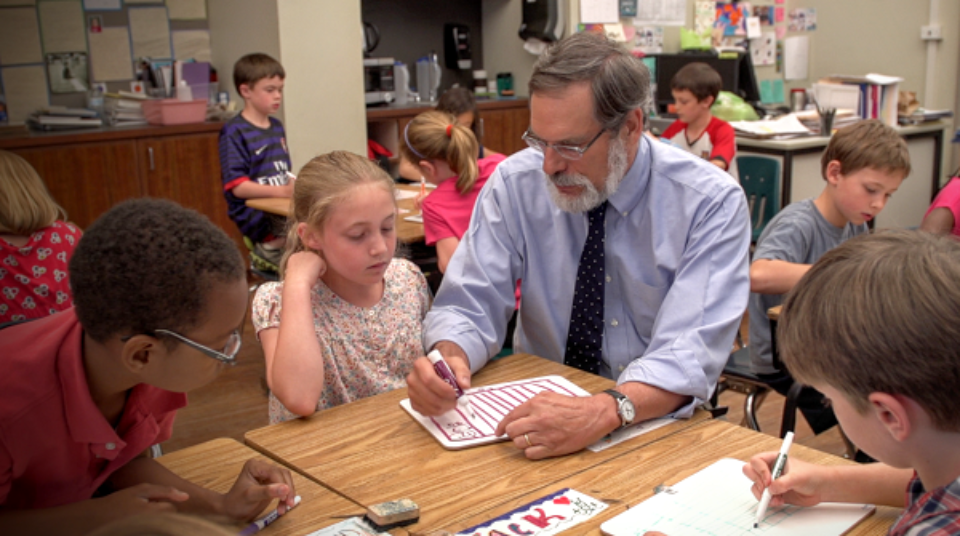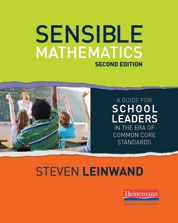
“The motivating force that makes educators so special is the understanding that taking the extra minute, going the extra mile, reaching out one additional time can, and often does, make the critical difference.” —Steve Leinwand
If you’ve ever heard Steve Leinwand speak, you know he is energetic and opinionated. More importantly, he is fiercely devoted to the best possible mathematics instruction for all students. In today’s blog, which is adapted from his bestselling book Sensible Mathematics, Steve reflects on what he’s learned that’s worthy of passing on to other educators.
Steve Leinwand:
For the past thirty or so years, I have been blessed. As a mathematics consultant in the Connecticut Department of Education from 1979 to 2001, I worked in dozens of school districts, hundreds of schools, and with thousands of dedicated and professional teachers of mathematics. I had the opportunity to work in an incredibly supportive and collegial State Department of Education where the question “How can we help?” has never been empty rhetoric. Since 2002, I have served as a principal research analyst at the American Institutes for Research in Washington, DC, where I have been able to work with the Microsoft Math Partnership in eight Puget Sound school districts, the General Electric Foundation’s Ensuring Futures program in six urban districts, and most recently in several School Improvement Grant “turn-around” schools. I have also had a wealth of varied experiences across the country as part of my activities within the National Council of Teachers of Mathematics and the National Council of Supervisors of Mathematics. Over this period of time and in these various roles, I have seen people make extraordinary changes. I have seen schools undergo major transformations and districts provide truly excellent mathematics programs. But far more often I have watched as ignorance, confusion, fear, a lack of leadership, or simply an unwillingness to move has relegated children and young adults to a truly mind-numbing mathematics program. Through it all—some truly amazing, some good, some bad, and some downright ugly—here is some of what I’ve learned and what I’d like to pass along to all who toil in the honorable vineyards of making mathematics truly work for all.
First, never stray from a dogged focus on classroom instruction.
Just as Bill Clinton won in 1992 in part by making “It’s the economy, stupid!” a campaign mantra, for educators and educational policy makers at all levels, the appropriate mantra must be “It’s the classroom, stupid!” When all is said and done, it’s not the buses, the buildings, or the budgets that determine how much and how well students learn, it’s the daily interactions between teachers and students, and among students, in the classrooms of every school that determines how much and how well students will learn. New materials, professional development, and effective supervision are all important only to the degree they support high-quality instructional interactions. When things are going well and students are learning, the causal path leads directly back to the classroom. Similarly, when things are not going well, when results are mediocre at best, and when students are bored and acting out, the same causal path points to the classroom. If one seeks to improve the quality of education and the quantity of student achievement, enhancing, empowering, energizing, and engaging teaching and teachers has always been and will continue to be the optimal choice.
Second, assessment is the most powerful change lever in our arsenal.
Good tests nudge along improvements and push people to make change. Bad tests perpetuate mediocrity and reinforce counterproductive practices. In the daily lives of most teachers and students it is the high-stakes assessments that are used that communicate what we value. Think how often students ask “Is this going to be on the test?” When told “Yes,” pencils and notebooks start to stir and attention gets paid. When told “No, this is just enrichment,” eyes start to glaze over and heads start to nod. That’s why improving and better aligning high-stakes state assessments has been one of the most popular strategies for encouraging change. And that’s why building influential and respected grade-level criterion-referenced tests and common course final examinations are often more important than the curriculum upon which they are purportedly based. Anyone interested in what is valued in the intended curriculum need look no further than the tests that students are given. When these tests regularly include interesting problems, extended tasks, explanations of reasoning, and justifications for actions and solutions, one can be sure reform is being supported and encouraged and that the learning of important mathematics is being stressed.
Third, everything we advocate must be grounded in concrete examples.
All good instruction is enhanced by examples that help the learner build on prior experiences, connect new ideas, concretize new concepts, and apply what is being learned. The same must be true in all our discussions about shifting mathematics programs. Unfortunately, as educators, we too often fall back upon the words of lectures and the abstractions of concepts, forgetting to consistently link our words and abstractions to what can actually be illustrated. That’s why we must pause and show each other exactly what we mean with clear and compelling examples. And that’s why exemplars, models, samples of student work, and videos are indispensable tools for helping people to understand our ideas and our vision.
Fourth, we need to toot our own horns much more frequently and much more loudly that we are often comfortable doing.
There is so much that is good in America’s elementary, middle, and high schools. There is much mathematics learning that is working well for millions of students. And there are thousands of pockets of extraordinary accomplishments that occur daily in America’s classrooms. But one would hardly know these things in the face of an incessant onslaught of news about the problems, the woes, and the failures of our schools. In far too many cases, we educators are our own worst enemies: At best, we think it’s unprofessional and unbecoming to taut our successes, and at worst, we express our frustrations in public and reinforce the ever-present negative perceptions. An important part of the best solution is to become our own public relations officers. At all levels of the system, it is time to gather data on what is working, celebrate successes with great fanfare, and publicize our not inconsiderable accomplishments. All corporations have public information personnel who are assigned to churn out the good news and put the best possible spin on events. Every politician either has a press secretary or acts as his or her own press agent to inform, promote, and publicize. Every school and every district should engage in commensurate promotion of the positive.
Finally, each of us must remember how much difference one person can make.
The enduring, yet haunting, beauty of the education profession is that each and every educator has the potential to make an extraordinary difference in the lives of students. But it is usually years before that difference is recognized, and rarely then is it even acknowledged. More often recognized, but no more frequently acknowledged, is the extraordinary difference every educator can make in the lives of colleagues. Thus, in classrooms and faculty rooms, in school, district, and state agency offices, the motivating force that makes educators so special is the understanding that taking the extra minute, going the extra mile, reaching out one additional time can, and often does, make the critical difference. Recognizing and acting on this simple truth can, and does, allow each of us to touch eternity.
Did you miss our recent interview with Steve? Click here to read part one now.
♦ ♦ ♦ ♦
 Steve Leinwand is Principal Research Analyst at American Institutes for Research in Washington, D.C., where he supports a range of mathematics education initiatives and research. Steve served as Mathematics Supervisor in the Connecticut Department of Education for twenty-two years and is a former president of the National Council of Supervisors of Mathematics. Follow him on Twitter @steve_leinwand.
Steve Leinwand is Principal Research Analyst at American Institutes for Research in Washington, D.C., where he supports a range of mathematics education initiatives and research. Steve served as Mathematics Supervisor in the Connecticut Department of Education for twenty-two years and is a former president of the National Council of Supervisors of Mathematics. Follow him on Twitter @steve_leinwand.


